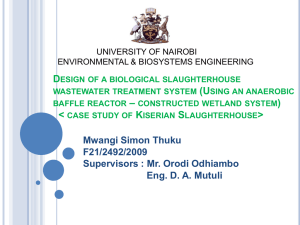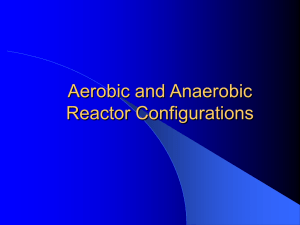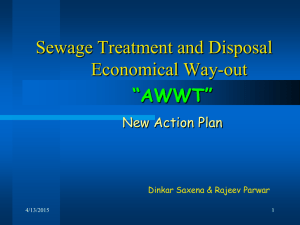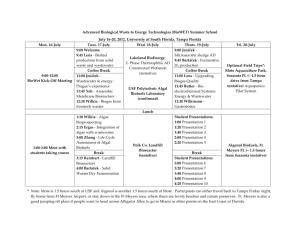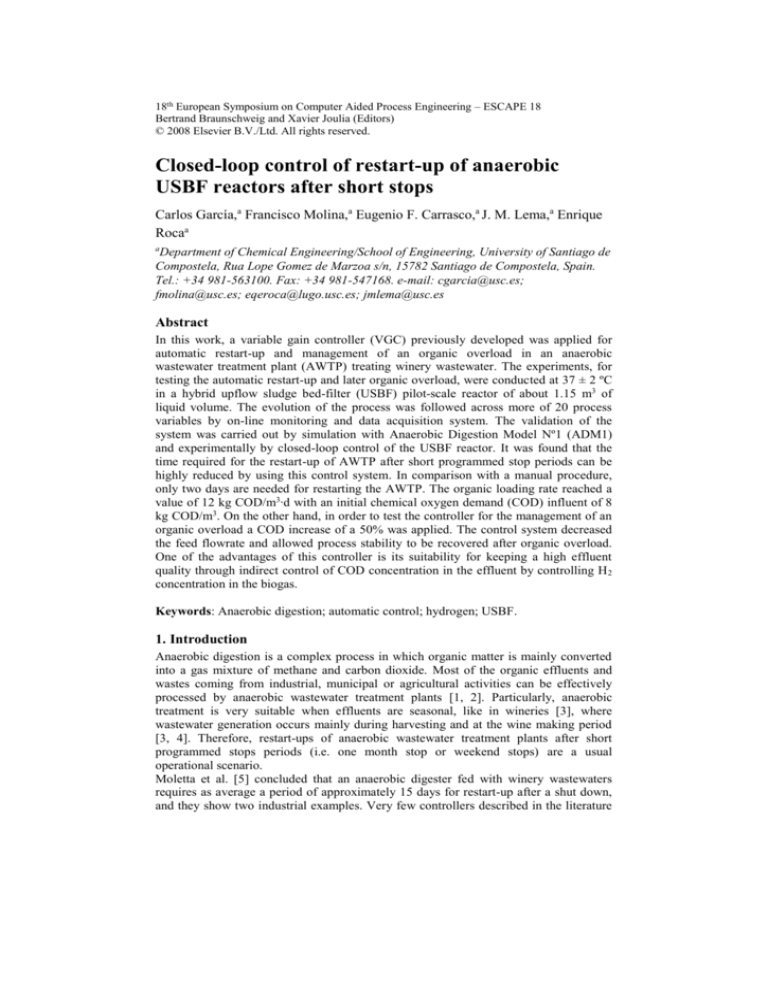
18th European Symposium on Computer Aided Process Engineering – ESCAPE 18
Bertrand Braunschweig and Xavier Joulia (Editors)
© 2008 Elsevier B.V./Ltd. All rights reserved.
Closed-loop control of restart-up of anaerobic
USBF reactors after short stops
Carlos García,a Francisco Molina,a Eugenio F. Carrasco,a J. M. Lema,a Enrique
Rocaa
a
Department of Chemical Engineering/School of Engineering, University of Santiago de
Compostela, Rua Lope Gomez de Marzoa s/n, 15782 Santiago de Compostela, Spain.
Tel.: +34 981-563100. Fax: +34 981-547168. e-mail: cgarcia@usc.es;
fmolina@usc.es; eqeroca@lugo.usc.es; jmlema@usc.es
Abstract
In this work, a variable gain controller (VGC) previously developed was applied for
automatic restart-up and management of an organic overload in an anaerobic
wastewater treatment plant (AWTP) treating winery wastewater. The experiments, for
testing the automatic restart-up and later organic overload, were conducted at 37 ± 2 ºC
in a hybrid upflow sludge bed-filter (USBF) pilot-scale reactor of about 1.15 m3 of
liquid volume. The evolution of the process was followed across more of 20 process
variables by on-line monitoring and data acquisition system. The validation of the
system was carried out by simulation with Anaerobic Digestion Model Nº1 (ADM1)
and experimentally by closed-loop control of the USBF reactor. It was found that the
time required for the restart-up of AWTP after short programmed stop periods can be
highly reduced by using this control system. In comparison with a manual procedure,
only two days are needed for restarting the AWTP. The organic loading rate reached a
value of 12 kg COD/m3∙d with an initial chemical oxygen demand (COD) influent of 8
kg COD/m3. On the other hand, in order to test the controller for the management of an
organic overload a COD increase of a 50% was applied. The control system decreased
the feed flowrate and allowed process stability to be recovered after organic overload.
One of the advantages of this controller is its suitability for keeping a high effluent
quality through indirect control of COD concentration in the effluent by controlling H 2
concentration in the biogas.
Keywords: Anaerobic digestion; automatic control; hydrogen; USBF.
1. Introduction
Anaerobic digestion is a complex process in which organic matter is mainly converted
into a gas mixture of methane and carbon dioxide. Most of the organic effluents and
wastes coming from industrial, municipal or agricultural activities can be effectively
processed by anaerobic wastewater treatment plants [1, 2]. Particularly, anaerobic
treatment is very suitable when effluents are seasonal, like in wineries [3], where
wastewater generation occurs mainly during harvesting and at the wine making period
[3, 4]. Therefore, restart-ups of anaerobic wastewater treatment plants after short
programmed stops periods (i.e. one month stop or weekend stops) are a usual
operational scenario.
Moletta et al. [5] concluded that an anaerobic digester fed with winery wastewaters
requires as average a period of approximately 15 days for restart-up after a shut down,
and they show two industrial examples. Very few controllers described in the literature
2
C. Garcia et al.
have demonstrated experimentally their ability for restart-up an anaerobic reactor. Some
examples in this field are the controllers developed by Ehlinger et al. [6] and Liu et al.
[7]. Restart-up periods of 16 days in a lab scale reactor with a decision tree controller
treating winery wastewater [6] and with a cascade control system 4 days [7],
respectively. Other controllers based in other control structures do not consider the
restart-up scenario and they would require several modifications or tuning to be able to
handle this operational situation. The automatic controlled restart-up of an anaerobic
wastewater treatment plant (AWTP) treating winery wastewater could give important
advantages in the management of these devices helping to minimize the time needed for
restarting the plants under safely conditions.
Recently, a variable gain controller (VGC) was developed for automatic control of
anaerobic wastewater treatment plants treating ethanol containing wastewater. This
control system presented a fast response against destabilization process and gave
promising results [8]. However, its reliability and suitability for industrial application
requires a further validation in different situations to test process control stability.
In this work, this controller was applied for the closed-loop control of an AWTP
treating ethanol containing wastewater. The controller was proved for the fast restart-up
of the plant after short periods of approximately 1 month. Furthermore, the controller
was validated against a consecutive unsteady set of conditions (restart-up followed by
an organic overload). The aim was to test the suitability and reliability for industrial
applications. Experiments were conducted during a period large enough for assuring
that the controller drove the process to stable conditions.
2. Materials and Methods
2.1. Pilot Plant
The experiments, for testing the automatic restart-up, were conducted at 37 ± 2 ºC in an
Upflow Sludge Bed Filter USBF (upflow anaerobic sludge blanket or UASB zone +
anaerobic filter or AF zone) pilot-scale reactor of about 1.15 m3 of liquid volume [9].
The temperature was controlled by means of an On/Off single loop. The available online measurement devices included feed and recycling electromagnetic flow-meters
(ABB, COPA-XE and Siemens, 7ME2531), input and output reactor pH (Cole Parmer)
and temperature (Pt 100); biogas flow-meter (Brooks, 3240); infrared gas analyzer
(Siemens, Ultramat 22P) for the measurement of CH4 and CO concentrations in gas
phase; electrochemical hydrogen gas analyzer (Sensotrans, Sensotox 420); on-line Total
Organic and Total Inorganic Carbon (TOC/TIC) were determined by catalyst
combustion oxidation and non dispersive infrared (NDIR) CO2 detection (Shimadzu,
4100). All data were on-line monitored by the sensors and recorded every 15 min. More
detailed descriptions of the equipment and data acquisition system were reported
elsewhere [10].
The biomass, inside of the reactor, during the experiments had a specific methanogenic
activity of 0.66 ± 0.18 kg COD / (kg VSS d). The average total biomass observed in the
reactor was 18.6 ± 1.5 kg VSS, meaning an average VSS concentration in the reactor of
16.9 ± 1.4 g/L [3].
Synthetic ethanol containing wastewater, emulating winery effluents, was used. The
influent composition consisted of dilute white wine, nutrients and alkalinity. The wine
dilution is done “in situ” using a static mixer just before entering the reactor to avoid
pre-acidification on the feeding tank. Nutrients and alkalinity were added in order to
maintain a COD/Bicarbonate/N/P ratio of 1000/400/7/1, required for the biomass
growth and to keep an adequate buffer capacity inside the reactor [11].
Closed-loop control of restart-up of anaerobic USBF reactors after short stops
3
2.2. Model
A Matlab-Simulink implementation of a modified version of the Anaerobic Digestion
Model Nº1 (ADM1) [12] incorporating ethanol degradation pathway and calibrated for
the USBF reactor [13] was used to predict the behavior for the automatic restart-up
control system. The use of calibrated liquid to gas mass transfer coefficients for
simulations with ADM1 allowed the response of the model gas-phase variables to be
improved. The high recycling flow rate applied (4.8 m3/d) to the USBF reactor
guarantees that the liquid phase presents perfect mixing reactor behavior in the UASB
zone [14]. The anaerobic filter zone (AF zone at top of the USBF reactor) only work as
phase’s separator.
2.3. Controller used for automatic restart-ups
A variable-gain controller (VGC) [8] has been selected for the automatic restart-up. The
controller acts over the feed flowrate (Q) considering the methane production rate
(QCH4) and the hydrogen concentration in the biogas (H2) as state variables. Each state
variable modifies the controller gain by means of two factors, the methane factor (fCH4)
and the hydrogen factor (fH2). The hydrogen factor (fH2), defined by Eq. (1) varies in a
range of [-1, 1] and establish the direction of change in the feed flowrate. On the other
hand, methane factor (fCH4), defined by Eq. (2) varies in a range of [0, 1] (equation 2)
and allows the controller to thrust the system to higher organic loading rate (OLR)
values as long as hydrogen remains below the set-point level (H2*).
f CH 4
(1)
n
1
H m
f H 2 1 2
H 2*
if H 2 H 2*
H *
fH 2 2 -1
H2
if H 2 H 2*
Q * CH 4
QCH 4 Q * CH 4
(2)
QCH4 and α are the maximum methane production rate and the thrust factor,
respectively.
Disturbances
H2*
Control law
Actuator:
Feed pump
Anaerobic
Reactor
CODe
QCH4
H2
Figure 1. Block diagram of the VGC in the implemented control scheme.
This controller was implemented in a single control loop (as shown in Figure 1) with
two inputs, methane flowrate (QCH4) and hydrogen concentration in the gas phase (H 2),
and only one output, the feed flowrate (Q) as control variable. In the automatic restartup validation procedure, the feed flowrate (Q) starts at an established small initial value
and its variation is determined by means of a discrete control law Eq. (3).
Qti Qti 1 Qti 1 t K f H 2 fCH 4
(3)
4
C. Garcia et al.
The values of the parameters (K, Q*CH4, α, m, n and H2*) used in the restart-up
experiments are listed in the Table 1. The K value was selected to limit the maximum
feed flowrate change to 10% each 15 minutes. The Q*CH4 value was, for security, a 90%
of the real maximum methane production determined experimentally. The thrust factor
(α) is a small value, 1% or similar. The parameters m and n were tuned by means of
simulations. And the hydrogen set point (H2*) was selected according to the last
operational conditions before shut down.
Controller Gain K (d-1)
0.4
m (-)
Q*
11.4
n (-)
3
CH4 (m CH4/d)
Thrust factor α (-)
0.01
2
10
*
Set point H2 (ppm)
25 / 22*
Table 1. Controller parameters used for restart-up experiments. * With ADM1 simulation.
3. Results and Discussion
The VGC system was tested using data generated by simulation with a modified ADM1
version and under closed-loop control of a USBF reactor treating wastewater containing
white wine diluted for emulating winery wastewater.
3.1. Restart-up simulation
Some researchers had identified to the ADM1 as a useful standard model for evaluating
controllers, and developing operational strategies and protocols. This is particularly
interesting for the treatment of winery and distillery wastewater since wine production
is seasonal and digesters often have to be restarted [15]. Thus, the automatic restart-up
of the USBF reactor by means of the VGC system was tested by simulation with
modified version of ADM1 [13]. For that purpose, the controller parameters used are
those presented in the Table 1. In these simulations, the chemical oxygen demand
(COD) concentration in the influent was fixed at 8 kg/m3 and was established an initial
feed flowrate of 0.6 m3/d.
Figure 2 shows the behavior of the controller during the simulation of restart-up with
ADM1. The process started at a low hydrogen concentration and methane production.
The feed flowrate is increased till the hydrogen concentration in the biogas reaches the
set-point value H2*. Initially the changes in feed flowrate are greater because the
methane productivity was low (Figure 2a). As hydrogen and methane production
increased, its factors decreased progressively. CODe surmounts 0.5 kg COD/m3 after
second day, while the system achieved very high removal efficiency (higher than 90%)
and a good effluent quality. On the other hand, the pH was kept stable near a neutral
value and the rest of variables (alkalinity, biomasses concentrations and volatile fatty
acids not showed here) during the simulation remained in acceptable values.
According to the simulations, the controller required three days approximately for the
restart-up period, till the reactor reaches almost its maximum capacity (OLR max). ADM1
simulations show that the proposed control strategy could highly improve the restart-up
time of a USBF used for the treatment of winery wastewater after a 1 month shutdown,
in comparison with the results showed by Molleta et al. [5] for the treatment of this type
of wastewater.
Closed-loop control of restart-up of anaerobic USBF reactors after short stops
Figure 2. State variables in the simulation with modified ADM1.
3.2. Experimental validation of automatic restart-up
The restart-up of the USBF reactor was carried out in automatic mode with the VGC
system in closed-loop. Different experiments are shown in order to demonstrate the
reliability of the controller for this operational situation. In Figure 3 are presented two
restart-ups experiments after seasonal stops (20 and 25 days respectively) with different
hydrogen set-points. For both experiments the initial COD concentration in the feeding
and the feed flowrate were 8 kg COD/m3 and 0.48 m3/d, respectively. Thus, the initial
OLR value (3.3 kg COD/m3.d) was far from the maximum theoretical and practical
capacity of the process, that were estimated in 14 and 13 kg COD/m3•d, respectively
[3].
In the first experiment (Figures 3a and 3b) a set-point of 25 ppm of hydrogen was
selected. In the Figure 3b, it can be observed that this set-point corresponds to a CODe
of 0.8 kg COD/m3. The selection of an adequate hydrogen set point is important for the
performance of this control system, as it is linked to the CODe and effluent quality at
steady state conditions. Moreover, simulations with modified ADM1 reveal a similar
behavior in this sense (22 ppm corresponds to near of 8 kg COD/m3 in CODe).
However the ratio between hydrogen concentration and CODe is expected to change
with time and it is highly recommended to consider this for the restart-up in closedloop. Therefore, in a similar way in the second experiment the hydrogen set-point was
established in 45 ppm, but in this case CODe was 0.4 kg COD/m3 in quasi steady state.
In the first experiment, the VGC managed the restart-up of the AWTP increasing the
OLR up to 10 kg COD/m3·d. The time necessary for starting-up was 2 days, achieving
a production of methane of 3.85 m3/d and a very good biogas quality (in agreement with
the stoichiometry for this residue) that remained close to 76 % of methane.
In the second restart-up experiment the final OLR achieved was nearby 14 kg
COD/m3·d. The time necessary for the restart-up period was similar to the obtained in
the previous experiment and the adaptation of the digester to the wastewater permitted
to have a cleaner effluent. The production of methane was of 5.4 m3/d, again with a very
good quality of biogas.
The quality of the effluent was very good during both restart-up experiments (Figures
3b and 3d) with a COD removal always higher than a 90 %. The pH changed very little
and it was near to neutral values during all restart-up period. The VGC system achieved
the automatic restart-up in a time lower than 3 days for both experiments.
5
6
C. Garcia et al.
Figure 3. Two restart-up experiments: 3a and 3b refers to experiment with set-point 25 ppmH2;
and 3c and 3d experiment with set-point 45 ppmH2.
3.3. Restart-up with later organic overload
In order to test the controller under other usual situations an organic overload was
applied on the final phase of a restart-up period. The change in the CODe concentration
was of a 50% (from COD influent of 8kg COD/m3 to 12 kg COD/m3).
The control system was able to handle the severe organic overload (12 kg COD/m3·d)
and returns towards stable operation. As in the last restart-up, a hydrogen concentration
set-point of 45 ppm was chosen. Only the quality of effluent in terms of CODe suffered
an important disturbance due to the overload with an increase from 0.6 kg COD/m3 to
1.67 kg COD/m3) while methane production reached a value of 4.25 m3/d.
Figure 4. Control and process variables evolution obtained during the validation experiment of
restart-up and consecutive organic overload.
Closed-loop control of restart-up of anaerobic USBF reactors after short stops
4. Conclusions
An automatic variable-gain control (VGC) system allows the restart-up of AWT plants
treating winery wastewaters and to recover stability of the process after an organic
overload. The automatic control device was tested in simulations with ADM1 and
experimentally in a 1.15 m3 USBF reactor treating a wastewater simulating winery
effluents. The system provided good performance keeping very high removal efficiency
and good effluent quality throughout all the period of starting and posterior organic
overload. The VGC demonstrated to be reliable, supplying an adequate control action to
achieve the restart-up end point conditions for AWT plant treating winery effluents.
Acknowledgements
Authors wish to acknowledge to Spanish National R&D Program and European
Regional Development Fund (ERDF) for the Project ANACOM CTQ2004-07811-C0201.
References
[1] P. McCarty, Water Sci. Technol., 44 (2001) 149.
[2] G. Lettinga, Water Sci. Technol., 52 (2005) 1.
[3] F. Molina, G. Ruiz, C. García, E. Roca and J.M. Lema, Water Sci. Technol., 56 (2007) 25.
[4] W.J.B.M. Driessen, M.H. Tielbaard and T.L.F.M. Vereijken, Water Sci. Technol., 30 (1994)
193.
[5] R. Moletta, Water Sci. Technol., 51 (2005) 137.
[6] F. Ehlinger, Y. Escoffier, J.P. Couderc, J.P. Leyris and R. Moletta, Water Sci. Technol., 29
(1994) 289.
[7] J. Liu, G. Olsson and B. Mattiasson, Biotech. & Bioeng., 87 (2004) 43.
[8] J. Rodríguez, G. Ruíz, F. Molina, E. Roca and J.M. Lema, Water Sci. Technol., 54 (2006) 57.
[9] A. Puñal, J. Rodríguez, A. Franco, E.F. Carrasco, E. Roca and J.M. Lema. Water Sci.
Technol., 43 (2001) 191.
[10] C. Garcia, F. Molina, E. Roca and J.M. Lema, Ind. Eng. Chem. Res., 46 (2007) 6707.
[11] R.E. Speece (Archae Press), Anaerobic Biotechnology for Industrial Wastewaters, USA,
1996.
[12] D.J. Batstone, J. Keller, R. Angelidaki, S.V. Kalyuzhny, S.G. Pavlostathis, A. Rozzi, W.T.M.
Sanders, H. Siegrist and V.A. Vavilin (IWA Publishing), Anaerobic Digestion Model Nº 1
ADM1. Report Nº13, London, 2002.
[13] G. Ruiz, J. Rodriguez, E. Roca and J.M. Lema, Modification of the IWA-ADM1 for
application to anaerobic treatment of ethanolic wastewater from wine factories. In
Proceedings: 10th World Congress on Anaerobic Digestion, Montreal, Canada, 2004.
[14] G. Ruiz (2005) Monitoring and advanced control of anaerobic reactors. PhD. Thesis.
Universidade de Santiago de Compostela, Spain.
[15] D.J. Batstone and J.P. Steyer, Water Sci. Technol., 56 (2007) 147.
7


